Text
OURBOROS AUTOPOIESIS - extreme EFX chain feedback looper

A feedback looper that squeezes the extreme out of your EFX-chain. Perfect for 'Tone scouts', sound-designers and those who like harsh noises. An extended version of the Death by Audio - Total Sonic Annihilation 2 pedal, the METSÄÄN version has a 3 stage MODE selector that switched between 'vanilla'/ORIGINAL and boosted HIGHS or LOWS, which exponentially enhances the sonic possibilities of the original pedal and allows for dynamic frequency shifts in a harsh noise live performance, for example. But this pedal is not just god for harsh noises, but also for subtle tone experimentation, imagine a sound modulator like a delay or tremolo modulating itself in a loop. wonderful textures and abstract saturation might occur. Sometimes, you might get not much out of it and with other set-ups a plethora of unexpected sonic gems. With some EFX chain set-ups an input signal is not needed, as you can generate no-input noise scapes. A experimental sound artist's treasure trove/ pandorra's box. This feedback looper enables you to send the output of your EFX-chain back into it's input, in NORMAL mode, you control the the amount with only the FEEDBACK (Note: this pot works counterclockwise) pot, but in the ACTIVE (indicated by a ultraviolet LED) mode you get hands-on control of GAIN, FEEDBACK, PHASE, FREQUENCY MODE and of course final OUTPUT LEVEL (to tame the potentially destructively loud signal.). The 4x 6.3mm mono sockets on the back side of the pedal are from left to right (when pointing away from you): OUTPUT, RETURN, SEND, INPUT. When the TRUE BYPASS (indicated with a green LED) is engaged, your signal still goes through your EFX-chain in the loop. The Power input is for 'boss-style', center negative 2.1mm DC plugs, that are pretty standard for EFX-pedals it needs 9V DC (PSU not included). Build into a standard die-cast aluminum enclosure individually painted in the the burned out industry camo pattern in chrome and black. Handmade by GRM for METSÄÄN. Buy here. (link to webshop)
youtube









#metsään#metsäänmachines#ourborosautopoiesis#thismachinekillsfascists#harshnoise#guitartone#tone#efxpedal#pedalboard#Youtube
3 notes
·
View notes
Text
BENJOLIN 1.6 - Eurorack module (16HP)

This is a BENJOLIN version adapted for eurorack (16HP), which includes several mods of the original design including output signals boosted to eurorack level and CV signal normalisations, controlled by the CV attenuators, when no external input is connected. The circuit and PCB layout is based on Forestcaver’s open source files (BENJOLIN 1.6, which has a bit of squarewave bleedthrough!) and on this module only the panel design and some component assembly is by me. The panel is made from sturdy standard PCB material and has an embossed chaotic pattern, the lettering is shiny silver and the screenprinted parts are white on black.
“The Benjolin is a multi-function synthesizer designed by Rob Hordijk. The module consists of four separate function blocks: two VCOs, a state variable filter and an additional circuit, invented by Hordijk himself, called a rungler. This particular arrangement emerged from Hordijk’s efforts to design a synthesizer that was, as he puts it, "bent by design”. As such, the module functions according to principles of chaos theory, where short to long sputtering patterns spontaneously transform themselves, at times, gradually, at others, quite suddenly, morphing into new pattern doublings and bifurcations. The chaotic character of the Benjolin is anchored in Hordijk’s rungler circuit. In essence, the rungler is an 8-step shift register that takes its data input from one oscillator (OSC X) and its clock input from the other (OSC Y). The output of the shift register is then fed into a primitive, digital-to-analogue converter, creating a stepped voltage pattern of variable length and depth, what Hordijk terms a “stepped havoc wave”. This rungler wave is then wired back into the oscillators, via the attenuator knobs (Run X and Run Y), creating the complex interference system that lends the Benjolin its unique, aleatoric character. The inclusion of a voltage-controlled filter expands these possibilities further into the audio realm. Its design includes Hordijk’s signature, Z-plane modulation circuitry, which produces all-harmonic distortion. This gives the filter that kind of warm, organic character, reminiscent of classic tube amplifiers. This is most palpable when the resonance of the filter is turned to the maximum, with both oscillators running in the audio range. The filter’s input comprises a mix of a PWM wave (derived from the triangle waves of each oscillator) and the rungler signal itself. As with each of the oscillators, a rungler attenuator (RUN F) allows modulation of the filter as well. To round things out, CV inputs for both the oscillators and filter are normalized, each via their respective attenuators. This allows for cross-modulation between the oscillators and a “sweeping” effect for the filter, hitched to Triangle Y.“
And here’s a more detailed presentation/lecture by Rob Hordijk recorded on video.
Handmade by GRM for METSÄÄN. Shipping from finland.
SOLD.




1 note
·
View note
Text
VOICE VANDAL - Digital delay with multi-band distortion/chopper

The VOICE VANDAL is a noisy 4 band DISTORTION with a obscure digital delay. Each DISTORTION frequency band can be engaged with a toggle switch. The FREQUENCY for all 4 bands is controlled by the FREQUENCY pot. This is interesting, because the DISTORTION can be adjusted in relation to the original signal and create some sort of under-/overtones. The distortion is created by some ultra fast digital on/off switching of the original signal creating square wave harmonics. The BLEND pot mixes the DRY signal with the distorted signal before it goes to the DELAY. The DELAY is controlled by a FEEDBACK and a TIME pot and a DELAY ON/OFF stomp switch. The enclosure is a recycled heavily textured (with thick paint and carvings) wooden box painted in the burned out industry camo pattern in matte black and silver. The pedal is TRUE BYPASS and both stomp switches have an UV indicator LED. A dedicated 15V DC PSU (center positive) with a euro plug is included. Handmade by GRM for METSÄÄN. Sold.






Below's a demo video of an much older build. Note: this one does not have the FREEZE function.
youtube
#voice vandal#distortion pedal#distortion#delay#delay pedal#metsään#thismachinekillsfascists#Youtube
3 notes
·
View notes
Text
ANAPHYLAXIS FILTER - WASPsynth multi-mode filter with double LFO and distortion (#3.2024)
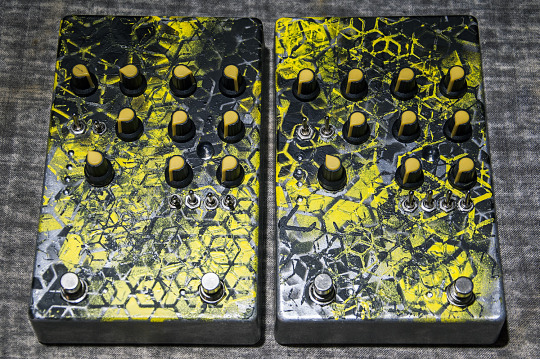
The ANAPHYLAXIS FILTER is a multi-mode filter with double LFO modulator for the CUTOFF frequency based the filter section of the notorious WASP synthesizer that was created by Electric Dream Plant in 1978. This standalone pedal version of the filter allows you to use it for the input signals of your choice. The FILTER MODE selector is a 4 position rotary switch (up to down: LOW PASS, BAND PASS, HIGH PASS and NOTCH) with the position indicated by small purple UV LEDs. The input signal is controlled with the GAIN control, that can boost even weaker input signal to overdrive the filter. A dedicated RESONANCE control determines the amount of RESONANCE at the CUTOFF point, that of course has a control knob as well. Furthermore the RESONANCE has two settings: EXTREME (up) and NORMAL(down), selected with a toggle switch. In HIGH PASS mode the filter can self-oscillate without any input, in case you need a high frequency SINE WAVE oscillator. In that case the FREQUENCY can be dialed in with the CUTOFF control. But the ANAPHYLAXIS FILTER can do more, as it has 2 build in LFOs that are modulating the CUTOFF frequency, with independent SPEED and DEPTH controls, which allows to generate a more complex modulation waveform. Each LFO has a RANGE toggle that selects: SLOW (down) or FAST (up) as well a 3 position toggle switch that selects the SHAPE: SQUARE (down), OFF (middle) and triangle (up). The fast LFO range goes well into audio range and enables you to create some very interesting frequency modulation filter effects. With slower rates, especially with the triangle shape and the 2 LFOs running at non-synced rates, even the most static sounding input get ‘alive’. The SPEED of each LFO is indicated by either red or green color in the big LED in the middle of the LFO section. The 1st stomp switch is TRUE BYPASS and if that is not enough, the 2nd stomp switch engages the DISTORTION, both with UV indicator LEDs. The level of the DISTORTION is controlled by the DISTORTION knob and the toggle switch next to it adds a TREBLE BOOST (up) or a HIGH CUT (down) setting to the DISTORTION. In the end of the signal path is a signal booster based on the EHX LBP1 with a global VOLUME control. The ANAPHYLAXIS FILTER runs on 9V DC and has a ‘boss style’ 2.1mm DC barrel plug socket with the negative pin inside. The enclosure is a heavy duty scavenged industrial engine power connector housing made from die-cast aluminum with a bottom plate made from found material and is painted in the industrial burnout camo pattern in matte black and bright yellow. Handmade by GRM for METSÄÄN.
SOLD.
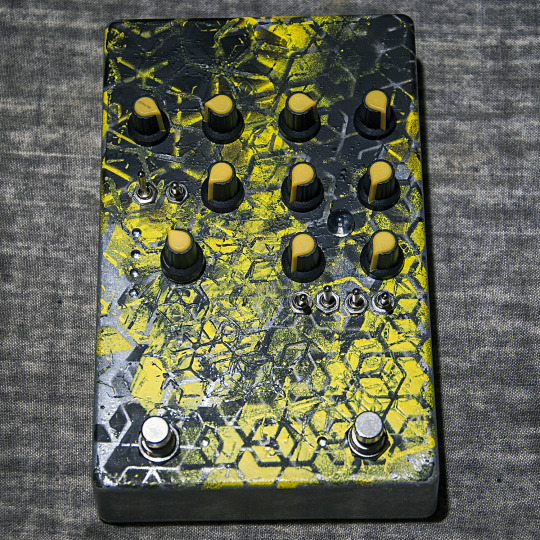



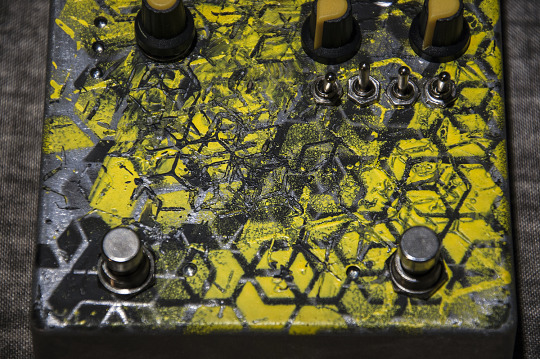


youtube
youtube
youtube
#anaphylaxis filter#waspsynth#wasp filter#wasp synthesizer#distortion#distortion pedal#filter pedal#effectpedal#Youtube
4 notes
·
View notes
Text
WASP FILTER - 1978 classic synth multi-mode filter with boosted distortion


The METSÄÄN - WASP FILTER takes the filter section from the legendary and notorious WASP synthesizer from 1978, with boosted resonance, combines it with a heavy distortion and brings it to pedal format, so you can mangle the signals of your choice with it in a small footprint. The controls in the top row from left to right are: Gain, Resonance, Distortion, Frequency, Volume. A 4 position rotary switch selects the Filter mode, either Low pass, Band pass, High pass or Notch filter. And a stomp switch with a purple indicator LED is for true bypass. The WASP FILTER runs on standard (boss-style/center negative pin) 9V DC pedal power supply. PSU is NOT included. The rugged die cast aluminum enclosure is painter in the industrial burnout camo pattern in bright yellow and matte black with the sanded silver grey aluminum surface lurking through. Handmade by GRM for METSÄÄN. Buy here. (link to webshop.)






2 notes
·
View notes
Text
ANAPHYLAXIS FILTER - WASPsynth multi-mode filter with double LFO and distortion
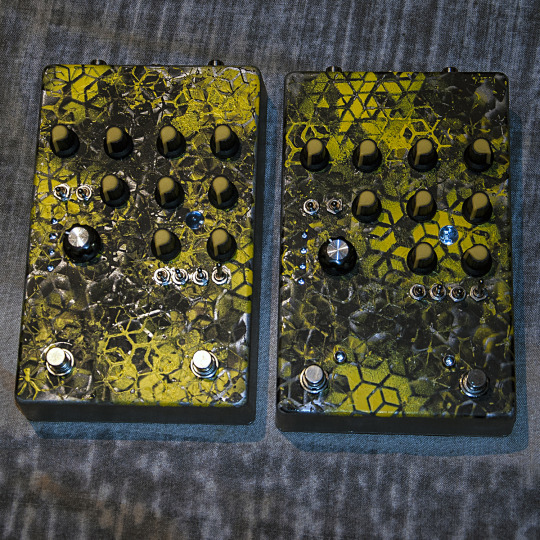
The ANAPHYLAXIS FILTER is a multi-mode filter with double LFO modulator for the CUTOFF frequency based the filter section of the notorious WASP synthesizer that was created by Electric Dream Plant in 1978. This standalone pedal version of the filter allows you to use it for the input signals of your choice. The FILTER MODE selector is a 4 position rotary switch (up to down: LOW PASS, BAND PASS, HIGH PASS and NOTCH) with the position indicated by small purple UV LEDs. The input signal is controlled with the GAIN control, that can boost even weaker input signal to overdrive the filter. A dedicated RESONANCE control determines the amount of RESONANCE at the CUTOFF point, that of course has a control knob as well. Furthermore the RESONANCE has two settings: EXTREME (up) and NORMAL(down), selected with a toggle switch. In HIGH PASS mode the filter can self-oscillate without any input, in case you need a high frequency SINE WAVE oscillator. In that case the FREQUENCY can be dialed in with the CUTOFF control. A 3.5mm mono input socket for EXTERNAL CV (Beware only use max. +5VDC, everything else destroys the circuit!). This input is used to modulate the filter’s CUTOFF with external gear (as i demonstrate in a demo video of a previous build). But the ANAPHYLAXIS FILTER can do more, as it has 2 build in LFOs that are modulating the CUTOFF frequency, with independent SPEED and DEPTH controls, which allows to generate a more complex modulation waveform. Each LFO has a RANGE toggle that selects: SLOW (down) or FAST (up) as well a 3 position toggle switch that selects the SHAPE: SQUARE (down), OFF (middle) and triangle (up). The fast LFO range goes well into audio range and enables you to create some very interesting frequency modulation filter effects. With slower rates, especially with the triangle shape and the 2 LFOs running at non-synced rates, even the most static sounding input get ‘alive’. The SPEED of each LFO is indicated by either red or green color in the big LED in the middle of the LFO section. The 1st stomp switch is TRUE BYPASS and if that is not enough, the 2nd stomp switch engages the DISTORTION, both with UV indicator LEDs. The level of the DISTORTION is controlled by the DISTORTION knob and the toggle switch next to it adds a TREBLE BOOST (up) or a HIGH CUT (down) setting to the DISTORTION. In the end of the signal path is a signal booster based on the EHX LBP1 with a global VOLUME control. The ANAPHYLAXIS FILTER runs on 9V DC and has a ‘boss style’ 2.1mm DC barrel plug socket with the negative pin inside. The enclosure die-cast aluminum painted in the industrial burnout camo pattern in matte black and bright yellow. Handmade by GRM for METSÄÄN.
Sold.


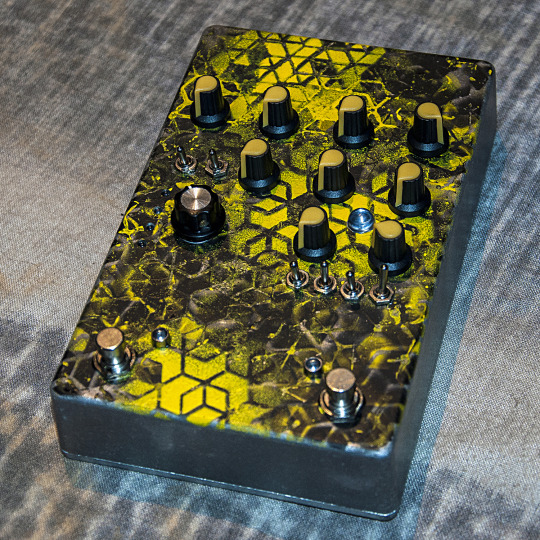
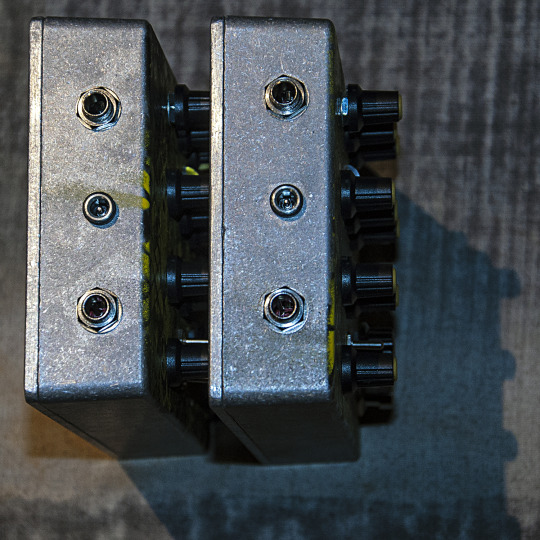

3 notes
·
View notes
Text
HARM ENGINE - square wave harmonics or digital sonic filth in +/- 5 octaves with 3rds and 5ths
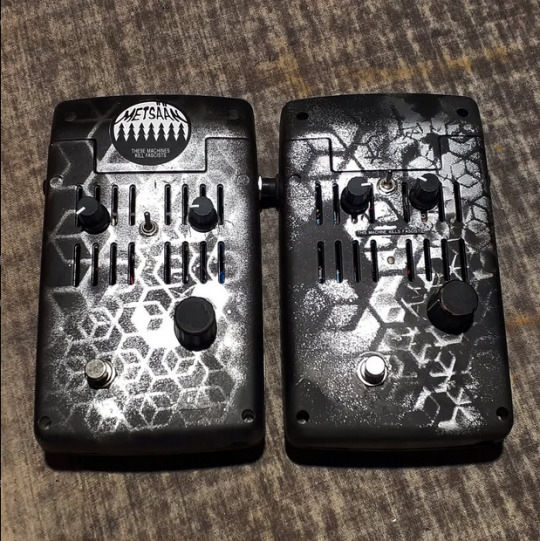
The HARM ENGINE is based on the CIRCUITBENDERS 'Harmonic Engine' PCBs, it's "a clone of the E&MM Harmonic Generator. This was a project by Paul Williams, published in Electronics & Music Maker magazine way back in 1981. The circuit uses a 4046 Phased Locked Loop (PLL) to generate a squarewave output at harmonic intervals to the frequency of the input signal. The squarewave can be set to +/- three [5 + a chaos noise mode in the METSÄÄN version] octaves, and can also produce 3rd or 5th harmonies. That's the theory anyway. In practice this only works reliably if you use very basic waveforms at the input. If you use anything else, then everything very quickly descends into a beautiful kind of chaos, with all kinds of bizarre gurgling digital squeaks and squeals vomiting forth. Its especially effective with percussion sounds, converting each hit into some kind of warped electronic splatter." The controls from top left to right are: SENSITIVITY - controlling the level at which the harmonics will be played. Turning the pot clockwise increases the gain of the signal (it also boost with a slight distortion, the DRY signal). In higher settings, the squarewave harmonics can form a modulated drone voice. Activity of the HARM ENGINE is indicated by a green LED, that turns on when harmonics are produced. 3RD/5TH - the 3 position toggle switch activates the corresponding detuning. The middle position is neutral. MIX - is a blending function to dial in the balance between DRY and HARM signal. If something is plugged into the DRY and HARM outputs on the rear of the machine, MIX stops working, because the signal is split before. OCTAVE - with a 12 position rotary switch, +/- 5 octaves are selected, 12o'clock is neutral and 6o'clock is the chaos/noise mode. TRUE BYPASS - The footswitch is configured for true bypass and has a pink indicator LED inside the machine, the glow can be seen through the vent grills in the enclosure. Build into a scavenged high voltage converter housing made from plastique painted in the 'burned out industry' camo pattern in matte black and chrome. Hand made by grm for METSÄÄN.
Sold.
youtube



...




11 notes
·
View notes
Text
ANAPHYLAXIS FILTER - WASPsynth multi-mode filter with double LFO and distortion

The ANAPHYLAXIS FILTER is a multi-mode filter with double LFO modulator for the CUTOFF frequency based the filter section of the notorious WASP synthesizer that was created by Electric Dream Plant in 1978. This standalone pedal version of the filter allows you to use it for the input signals of your choice. The FILTER MODE selector is a 4 position rotary switch (up to down: LOW PASS, BAND PASS, HIGH PASS and NOTCH) with the position indicated by small purple UV LEDs. The input signal is controlled with the GAIN control, that can boost even weaker input signal to overdrive the filter. A dedicated RESONANCE control determines the amount of RESONANCE at the CUTOFF point, that of course has a control knob as well. Furthermore the RESONANCE has two settings: EXTREME (up) and NORMAL(down), selected with a toggle switch. In HIGH PASS mode the filter can self-oscillate without any input, in case you need a high frequency SINE WAVE oscillator. In that case the FREQUENCY can be dialed in with the CUTOFF control. A 3.5mm mono input socket for EXTERNAL CV (Beware only use max. +5VDC, everything else destroys the circuit!). This input is used to modulate the filter’s CUTOFF with external gear (as i demonstrate in a demo video of a previous build). But the ANAPHYLAXIS FILTER can do more, as it has 2 build in LFOs that are modulating the CUTOFF frequency, with independent SPEED and DEPTH controls, which allows to generate a more complex modulation waveform. Each LFO has a RANGE toggle that selects: SLOW (down) or FAST (up) as well a 3 position toggle switch that selects the SHAPE: SQUARE (down), OFF (middle) and triangle (up). The fast LFO range goes well into audio range and enables you to create some very interesting frequency modulation filter effects. With slower rates, especially with the triangle shape and the 2 LFOs running at non-synced rates, even the most static sounding input get ‘alive’. The SPEED of each LFO is indicated by either red or green color in the big LED in the middle of the LFO section. The 1st stomp switch is TRUE BYPASS and if that is not enough, the 2nd stomp switch engages the DISTORTION, both with UV indicator LEDs. The level of the DISTORTION is controlled by the DISTORTION knob and the toggle switch next to it adds a TREBLE BOOST (up) or a HIGH CUT (down) setting to the DISTORTION. In the end of the signal path is a signal booster based on the EHX LBP1 with a global VOLUME control. The ANAPHYLAXIS FILTER runs on 9V DC and has a ‘boss style’ 2.1mm DC barrel plug socket with the negative pin inside. The enclosure is a heavy duty scavenged industrial engine power connector housing made from die-cast aluminum with a bottom plate made from found material and is painted in the industrial burnout camo pattern in matte black and bright yellow. Handmade by GRM for METSÄÄN. Sold.
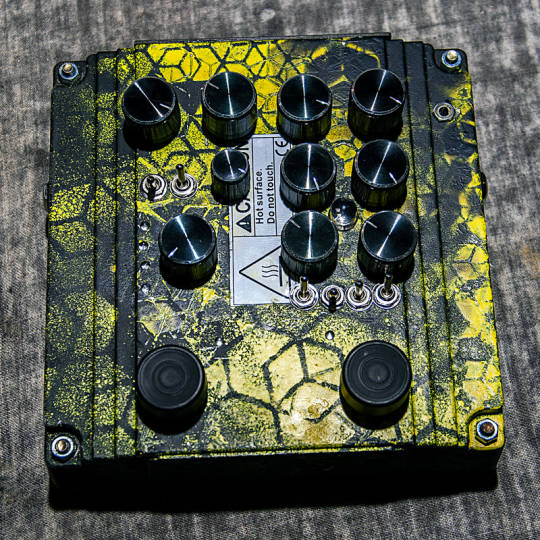
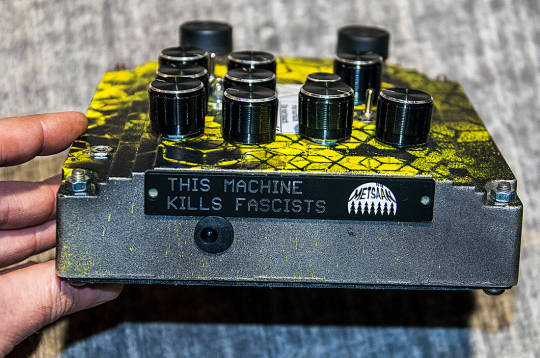




#anaphylaxis filter#distortion#multi mode filter#waspsynth#waspfilter#metsään#thismachinekillsfascists
4 notes
·
View notes
Text
youtube
An almost METSÄÄN exclusive NOISE ENSEMBLE set-up with:
GOJIRA DESTRUCTION
WAR HEAD
ECHOBLENDER
DIRTY DRONE DISTORTION
HARD CUTS
By the time of uploading this video, all of these machines are still available.
1 note
·
View note
Text
GOJIRA DESTRUCTION - brutal signal distortion with 3 interactive variables
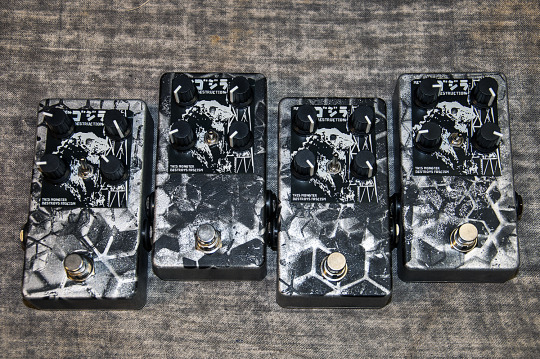
The GOJIRA DESTRUCTION distortion pedal is based on the rare GREEN MONSTER pedal (taken off the market for obvious reasons!), but it also includes a booster (LBP1) to increase the output level after it has been shattered, but it still works best in combination with other high gain pedals. This machine produces the most noisy and harshest signal distortion, that i have come across so far. Like the name-sake, it leaves nothing unharmed and reduces 'what once was' to smoldering debris. The 3 VARIABLES of the sound are very interactive and have to be dialed in to 'sweet spots', for useful distortions. [WARNING: This pedal is really strange and besides the mentioned 'sweet spots', there is also a lot of totally destroyed and most likely useless sounds emerging from the rubble.] The top right pot is the VOLUME knob, the others the variables and the toggle switch selects two slightly different GAIN settings. It is a TRUE BYPASS effect with a green indicator LED, build into a die-cast aluminum enclosure painted with an unique ‘burned out industry’ camo pattern and a piece of PCB around the knobs. Power-socket: 9V DC , 2,1mm DC jack boss-style (inside -/+ outside) PSU is NOT included. Handmade by GRM for METSÄÄN. Buy here. (link to webshop.) Demovideo follows.
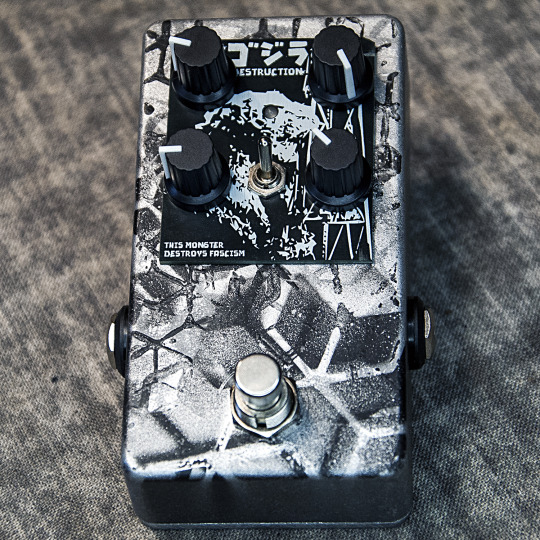
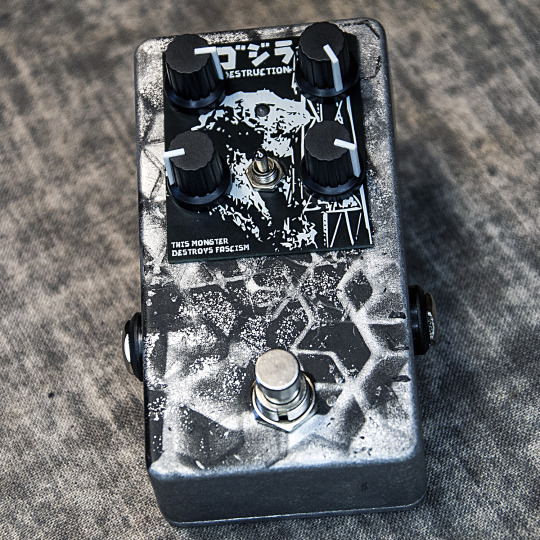
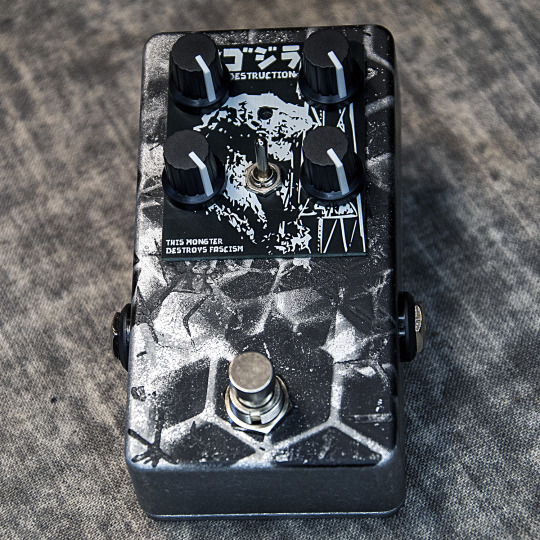
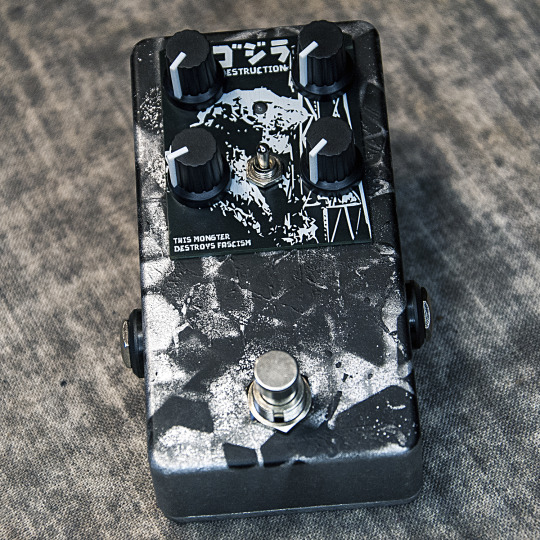
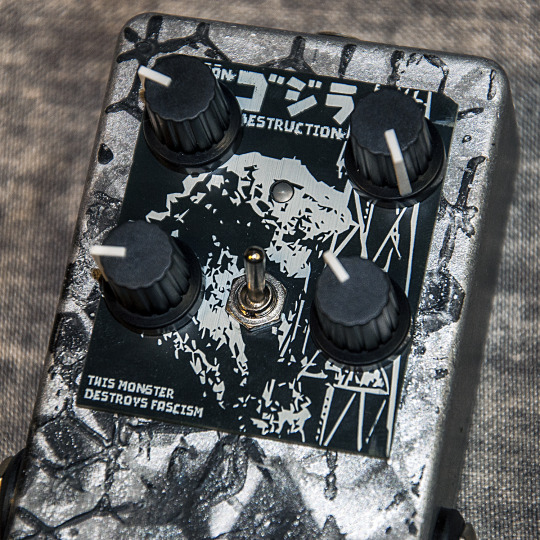
5 notes
·
View notes
Text
WAR HEAD - a versatile fuzz with massive boost

WAR HEAD is a versatile fuzz based on a clone of an obscure BIG MUFF clone, that is also known as the very popular FUZZ WAR. Additionally these METSÄÄN machines also contain a massive booster circuit (based on the EHX LBP1) to give you the full blast of signal shredding in one pedal. The top left pot is the input GAIN and the one right of that is the output VOLUME pot. Below those in the middle is the TONE control, ranging from a deep low end rumble to tissue slicing high frequencies. It is a TRUE BYPASS effect with a green indicator LED, build into a die-cast aluminum enclosure painted with an unique ‘burned out industry’ camo pattern and a piece of PCB around the knobs. Power-socket: 9V DC , 2,1mm DC jack boss-style (inside -/+ outside) PSU is NOT included. Handmade by GRM for METSÄÄN. Shipping from finland. BUY HERE. (link to new webshop) Here's a little video clip of the WAR HEAD in action: https://www.instagram.com/reel/DBWSksjt3uZ






7 notes
·
View notes
Text
DIRTY DRONE LOWLIFE - a subbass / drone / noise texture generator
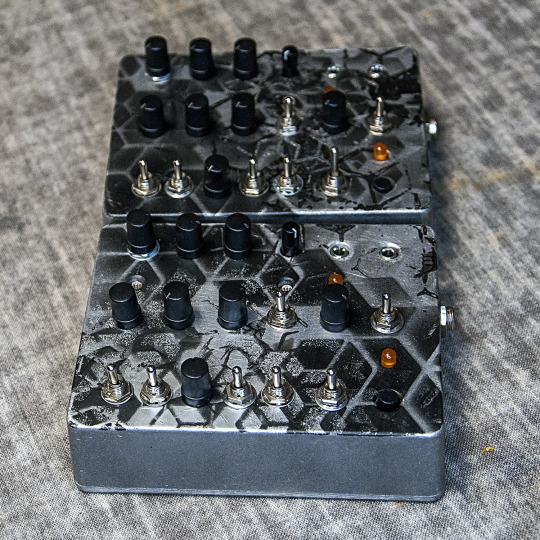
The Dirty Drone Lowlife is an experimental subbass and drone texture generator. It can be manually triggered by a TRIGGER button and externally with a TRIGGER/GATE input. The DECAY has a SHORT/LONG switch to select the range and a DECAY pot to fine tune it, from snappy to loooong. An orange LED indicates triggers and the decay (only dim with short triggers on long decay settings). With the DRONE toggle switch it can be set to play a constant drone sound as well. The sound's waveform is generated by two oscillators each with an array of possible settings: TRIANGLE/SQUARE and CLEAN/DIRTY toggle switches and of course a FREQUENCY control. Oscillator 1 has an additional OFFSET control, that can (in the range from 1.6V-2.6V) also get modulated by external control voltage via the CV input (with an orange indicator LED). Both oscillators are mixed with the BLEND control, that allows to shape the output waveform in a relatively linear manner, but the build in LDRs (Light Dependent Resistors) can also be used for that, when they are selected with the BLEND SELECT toggle switch, the user can ‘throw shade’ or ‘shine light’ on the build in sensors for a non-linear modulation of the oscillator BLEND. so it is possible to modulate the sound by hand gestures, for example. After that the signal runs through a resonant low pass filter with CUTOFF FREQUENCY, RESONANCE and SATURATION control. (please, keep in mind that in trigger mode it does not get completely quiet with no trigger.) In the end of the signal chain is a VOLUME control. Build into a die-cast aluminum enclosure painted with an unique 'burned out industry' camo pattern. Power-socket: 9V DC , 2,1mm DC jack boss-style (inside -/+ outside) PSU is NOT included. Handmade by GRM for METSÄÄN. Sold. Here’s demovideo of a previous build:
youtube
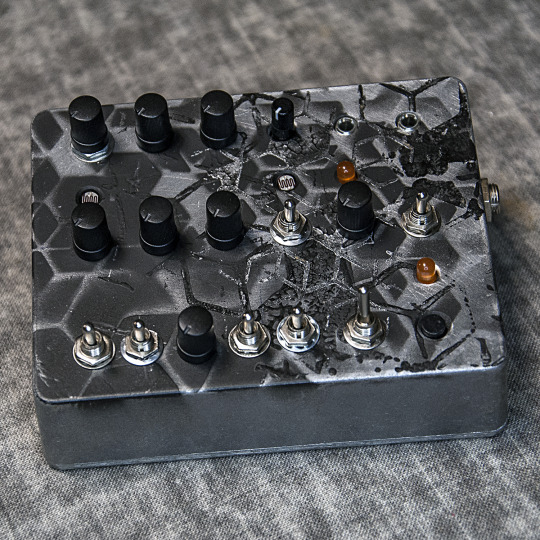
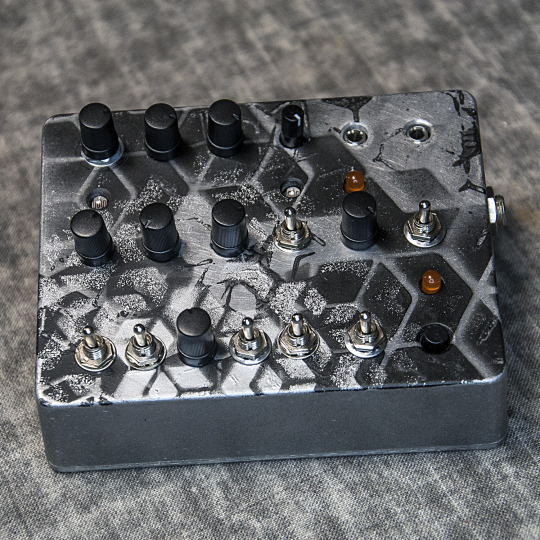
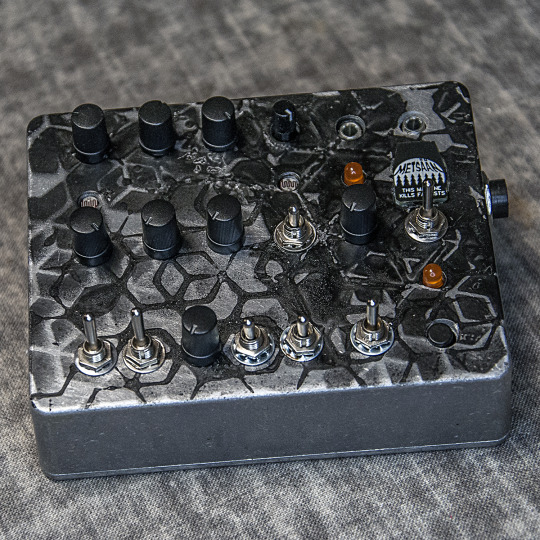
2 notes
·
View notes
Text
CIRCULAR COUGHING - hands on feedback noise

Trick question: - What came first? Speaker, Contact microphone, Vibration or Amplification! Hard to say in a open feedback circuit, but clear is that you can interact, with it by changing position of the piezo disk based contact microphone and/or adding material on top of the very sensitive cone, to rattle, resonate and filter the vibrations. There certainly are good and bad vibes to explore here. Tiny shifts in positioning can chage the sound drastically. Experiment! Via an 6.3mm socket output the amplified sounds can be send to mixer or EFX chain, a GAIN control pot and a 3 stage filter toggle switch adjusts the sensitivity and the sound. The circuit runs on 9V DC. the box is a recycled octagonal wooden 'home decor' accessory painted in an unique 'burned out industry' camo pattern. Handmade by GRM for METSÄÄN. Sold. (get in contact, if you are interested in such a machine.)





0 notes
Text
ECHOBLENDER - experimental delay/distortion fog maschine

The ECHOBLENDER is based on the “Echobender” by Casper Electronics with some tweaks for improved control. A device for dark echos (low pass filtered) and the ‘blackened’ noise of the internal distortion feedback. This machine is a delay/distortion bastard. Plus it kills fascists! The controls, from upper left to lower right: DRY VOLUME, FEEDBACK(DISTORTION), WET VOLUME, COARSE TIME, FINE TIME, REPEATS. It’s a true-bypass effect with a foot-switch and a ultraviolet indicator LED and an orange clipping/limiting diode in the feedback path to make better use of the self oscillations. Instead of just a blend pot, the ECHOBLENDER has two separate VOLUME pots for a precise mix of DRY and WET signal. With the WET at zero, the DRY also works as a signal BOOSTER to increase volume of the input signal. The FEEDBACK pot let’s you play with the self-oscillation and/or distortion capabilities of this versatile effect. With the DECAY fully clockwise you get classic delay self-oscillations. Get lost in a world of foggy delay noise clouds. Build into a die-cast aluminum enclosure painted with an unique 'burned out industry camo' pattern with a METSÄÄN sticker. Power-socket: 9V DC , 2,1mm DC jack boss-style (inside -/+ outside) PSU is NOT included.Handmade by GRM for METSÄÄN. BUY HERE. (link to webshop.)


(the one directly above is already sold, before the listing. sorry.)

Some demos from previous builds (there are more on my uuutube channel):
youtube
youtube
2 notes
·
View notes
Text
DIRTY DRONE LOWLIFE + ECHOBLENDER #5

The DIRTY DRONE LOWLIFE + ECHOBLENDER is an experimental subbass and drone texture generator combined with an experimental delay/distortion unit. It is housed in a die-cast aluminum pedal enclosure painted with the 'burned out industrial camo' patterns. The DIRTY DRONE LOWLIFE can be manually triggered by a TRIGGER button and externally with a TRIGGER/GATE input. The DECAY has a SHORT/LONG switch to select the range and a DECAY pot (works counterclockwise) to fine tune it, from snappy to loooong. An orange LED indicates triggers and the decay. With the DRONE toggle switch it can be set to play a constant drone sound as well. The sound is that of two oscillators each with an array of possible settings: TRIANGLE/SQUARE and CLEAN/DIRTY toggle switches and of course a FREQUENCY control. Oscillator 1 has an additional OFFSET control, that has a CV input with a very limited useful range from 1.6-2.6V (with an orange indicator LED). Both oscillators are mixed with the BLEND control, that allows to shape the output waveform in a relatively linear manner, but the build in LDRs (Light Dependent Resistors) can also used for that. When they are selected with the BLEND SELECT toggle switch ‘throwing shade’ or ‘shining light’ allows for a non-linear modulation of the blend, by hand gestures for example. The signal then runs through a resonant low pass filter with CUTOFF FREQUENCY, RESONANCE and SATURATION control. In the end of the signal chain is a VOLUME control. From there it either goes to the DRY OUT or if nothing is plugged into the DRY OUT to the ECHOBLENDER, which also as an input for an external signal, so it can be used independently from the LOWLIFE.
The ECHOBLENDER is based on the “Echobender” by Casper Electronics with some tweaks for improved control. A device for dark echos (low pass filtered) and the ‘blackened’ noise of the internal distortion feedback. These machine is a delay/distortion bastard. Plus they kill fascists! The controls, from upper left to lower right: DRY VOLUME, FEEDBACK(DISTORTION), WET VOLUME, COARSE TIME, FINE TIME, REPEATS. It’s a true-bypass effect with a foot-switch and a ultraviolet indicator LED and an orange clipping/limiting diode in the feedback path to make better use of the self oscillations. Instead of just a blend pot, the ECHOBLENDER has two separate VOLUME pots for a precise mix of DRY and WET signal. With the WET at zero, the DRY also works as a signal BOOSTER to increase volume of the input signal. The FEEDBACK pot let’s you play with the self-oscillation and/or distortion capabilities of this versatile effect. With the DECAY fully clockwise you get classic delay self-oscillations. Get lost i a world of foggy delay noise clouds. Handmade by GRM for METSÄÄN. Sold. (this was a commission build.) Here's demovideo of a previous build:
youtube
1 note
·
View note
Text
FONDLEFON - a handheld double coil/spring haptic noise generator with kill-switch (2nd batch)

The METSÄÄN - FONDLEFON is a handheld double coil/spring haptic noise generators with kill-switch, that works best with high gain distortion/fuzz and whatever harsh-noise EFX chain you're using. Heavy duty aluminum die cast enclosure with unique 'burned out industry' camo patterns and some heft to it, due to the 2 coils inside. This is the 2nd batch, it has slightly louder output, due to the row of drill holes between springs and coils. Handmade by GRM for METSÄÄN. Available here. (link to webshop)
youtube







1 note
·
View note
Text
SOLAR BURN OUT - a little noise synth with body contacts

A little hard to describe (harsh, chaotic) noise synth, build into a former solar panel charge control enclosure made from steel. the fact that it was metal, has made the enclosure survive a burn-out of a trailer in my old home. With 4 very interactive dials and two toggle switches, simulate the the idea this little noise beast is under your control. A set of 6 body contacts, of which some only have an audible effect in very specific settings of the dials, make the sonic explorations of this mysterious machine interesting, but it needs an EFX chain for full potential. Red power indicator LED on the side. Powered by 9V DC via a ‘boss-style’ 2.1mm DC socket (negative pin inside). Power supply NOT included. Unique build by GRM for METSÄÄN. Sold.


3 notes
·
View notes